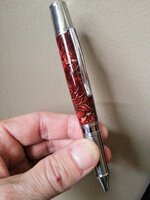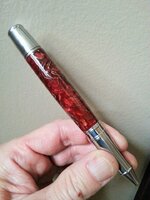thewishman
Member
This is one way to do it:
I take a few small pieces of plexiglas and dissolve it
in acetone. There are a couple of types of acrylic,
my first batch melted into a glob but didn't dissolve.
The correct type will start to dissolve immediately
and will go into solution in a couple of days. I use a
mason jar to hold my solution. I got my plexi at Lowes
from their window department - I asked for cutoffs and
got a big piece for $1.00.
After the plexi is dissolved I pour it into a clear
condiment bottle (Wal-Mart $.79) and add a bit more
acetone until the solution is a bit thicker than thin
CA glue. You can experiment to get your ideal
viscosity, some people like the solution much thicker
than mine.
I sand my blanks to 400 grit and then remove all of
the dust from them. I lay newspaper across my lathe,
under the mandrel and set the lathe at 1800 rpm, I
also have a spacer bushing at each end of the mandrel.
I put a small bag from a pen kit and put it over my
index finger, fold a 1/2 paper towel to about 1/2 inch
wide.
Put a couple of drops of solution on the paper towel
and run it under the spinning blanks. Start applying
just a little pressure on the bushing set before the
blank and make a smooth motion through the bushing at
the opposite end (the motion should take about as long
as it takes to say "motion.") Then put another drop on
the towel and go the opposite way, use enough solution
so that the towel is transferring the solution to the
blanks through the whole range. I put 25-30 coats on
in a couple of minutes (drip, slide, drip, slide) it
dries quickly enough that the time it takes to add a
drip is all the time you need to wait. (Thicker
solutions mean slower drying time.)
After the coats have been applied, I let the lathe
spin for 2-3 minutes and then start wet sanding with
Micro Mesh. Be careful with the 1500 grit, with my
first few tries I removed most of the plexi with that
one. Just a few seconds with moderate pressure is
enough for each grit, and dry off the blank between
grits to remove the slurry. The MM work is done at the
same 1800 rpms. After some practice the whole
procedure from the first drop to removing the polished
blanks takes about 5 minutes.
I turn the lathe off and use a utility knife to score
the plexi just a bout 1/16 - 1/8 inch beyond the end of
the blank, be careful to do it lightly so you don't
cut into your bushings. I learned the hard way to
score, since the finish is built up on the bushings as
well as the blanks. I then remove the blanks and trim
any extra finish off the ends. I tilt the blanks at a
slight angle and rub the sharp edges on some high grit
sandpaper, 500+, to get rid of the sharpness.
A couple of extra tips:
Do not press hard on the blank when applying the solution, just enough for the liquid on the paper towel to transfer to the blank.
If the finish starts getting bumpy or starts to look opaque, stop. You will not be able to make it better by continuing. Let it cure for a couple of minutes and sand it off, then start again. (I get in a hurry and scrape it off with a thumbnail before it cures.)
I recently saw the pen I used to demonstrate this process in 2007, the customer uses it daily and it is still shiny.
This process is quick, cheap and easy and customers are usually impressed when you tell them that you made the finish yourself. 30 coats will make the finish just a few thousandths thick.
Plexi works well over Silmar 41 and Alumilite and segmented blanks. Be sure to seal woods before applying plexi, I use thin CA and 400 grit sandpaper to create a slurry to seal the wood, then sand off the shiny parts, some woods ( those with open pores like walnut and oak) will require several sealings, regular sanding sealer also works.
I take a few small pieces of plexiglas and dissolve it
in acetone. There are a couple of types of acrylic,
my first batch melted into a glob but didn't dissolve.
The correct type will start to dissolve immediately
and will go into solution in a couple of days. I use a
mason jar to hold my solution. I got my plexi at Lowes
from their window department - I asked for cutoffs and
got a big piece for $1.00.
After the plexi is dissolved I pour it into a clear
condiment bottle (Wal-Mart $.79) and add a bit more
acetone until the solution is a bit thicker than thin
CA glue. You can experiment to get your ideal
viscosity, some people like the solution much thicker
than mine.
I sand my blanks to 400 grit and then remove all of
the dust from them. I lay newspaper across my lathe,
under the mandrel and set the lathe at 1800 rpm, I
also have a spacer bushing at each end of the mandrel.
I put a small bag from a pen kit and put it over my
index finger, fold a 1/2 paper towel to about 1/2 inch
wide.
Put a couple of drops of solution on the paper towel
and run it under the spinning blanks. Start applying
just a little pressure on the bushing set before the
blank and make a smooth motion through the bushing at
the opposite end (the motion should take about as long
as it takes to say "motion.") Then put another drop on
the towel and go the opposite way, use enough solution
so that the towel is transferring the solution to the
blanks through the whole range. I put 25-30 coats on
in a couple of minutes (drip, slide, drip, slide) it
dries quickly enough that the time it takes to add a
drip is all the time you need to wait. (Thicker
solutions mean slower drying time.)
After the coats have been applied, I let the lathe
spin for 2-3 minutes and then start wet sanding with
Micro Mesh. Be careful with the 1500 grit, with my
first few tries I removed most of the plexi with that
one. Just a few seconds with moderate pressure is
enough for each grit, and dry off the blank between
grits to remove the slurry. The MM work is done at the
same 1800 rpms. After some practice the whole
procedure from the first drop to removing the polished
blanks takes about 5 minutes.
I turn the lathe off and use a utility knife to score
the plexi just a bout 1/16 - 1/8 inch beyond the end of
the blank, be careful to do it lightly so you don't
cut into your bushings. I learned the hard way to
score, since the finish is built up on the bushings as
well as the blanks. I then remove the blanks and trim
any extra finish off the ends. I tilt the blanks at a
slight angle and rub the sharp edges on some high grit
sandpaper, 500+, to get rid of the sharpness.
A couple of extra tips:
Do not press hard on the blank when applying the solution, just enough for the liquid on the paper towel to transfer to the blank.
If the finish starts getting bumpy or starts to look opaque, stop. You will not be able to make it better by continuing. Let it cure for a couple of minutes and sand it off, then start again. (I get in a hurry and scrape it off with a thumbnail before it cures.)
I recently saw the pen I used to demonstrate this process in 2007, the customer uses it daily and it is still shiny.
This process is quick, cheap and easy and customers are usually impressed when you tell them that you made the finish yourself. 30 coats will make the finish just a few thousandths thick.
Plexi works well over Silmar 41 and Alumilite and segmented blanks. Be sure to seal woods before applying plexi, I use thin CA and 400 grit sandpaper to create a slurry to seal the wood, then sand off the shiny parts, some woods ( those with open pores like walnut and oak) will require several sealings, regular sanding sealer also works.


